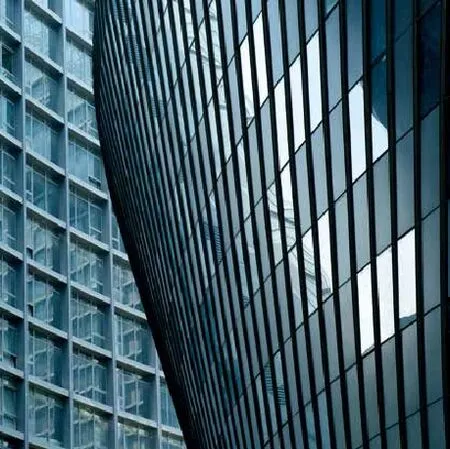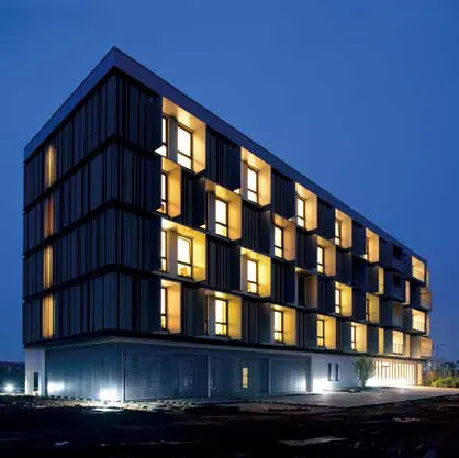不同文化之间的建筑
Wolf Guenter Thiel,文化研究员
Wolf guenter Thiel, Researcher, cultural studies
不同文化之间的建筑
ARCHITECTURE IN BETWEEN CULTURES
Wolf Guenter Thiel,文化研究员
Wolf guenter Thiel, Researcher, cultural studies
邻近河流,我们才能看到鱼,邻近山脉,我们才能听到鸟的歌声。
世界上三分之一的二氧化碳大气污染是由建筑物所产生的。为了减少这种排放,以满足全球气候变暖的挑战,建筑师们正在为解决可持续发展和生态保护问题而努力。他们在高效节能建筑方面和科学家,研究人员,工业企业以及客户等合作。由此,他们必须采用新现代主义的态度,利用高效率的技术解决方案,还有使用因地制宜的战略。
Peter Ruge是一位德国建筑师,其事务所总部设在柏林。他也在德国德绍建筑研究院教学可持续设计课程。他在可持续建筑领域有着丰富的专业知识,体现在其多个建筑作品获得了德国国家可持续建筑认证。他的建筑尊重当地人文条件,体现出他的核心价值观就是人类发展和个人福祉。现代化是一个跨文化,跨宗教,跨政治的理念,这就需要去适应当地的传统和行为。这意味着现代的建筑技术都是为了服务于不断更新的文化传统和态度。通过这个,他的建筑可以称为他对文化的理解,对文化的一种表达。
建筑师要理解当地文化是一个复杂的过程,从城市发展,社会分层,语言沟通,支配形式以及自然环境等方面。对他来说,一栋大楼不是一个孤立的个体,而是一个可以与周围环境适应并共享资源的机制。这样一来,建筑不仅可以更智能,也可以和自然构成一种和谐的关系。
2010年杭州会议中心的外立面设计就是一个很好的例子,杭州是浙江省的省会。“浙江省以盛产茶叶而著称,为了表达该地域特性,建筑的外观设计主要是叠加了茶的种植路径和种植网的轮廓。(Peter Ruge)“建筑看起来像多层的编织物所覆盖,并赋予它以一种真实的建筑形态。从远处看,建筑外观就像一个刚性体,但是当走近时就会发现水平的和竖直的结构网格。该建筑就是与杭州的整体环境融合一体,成为杭州的人文景观的一部分。
Ruge认为他的工作是将两种文化的结合。文化的差异不是要点,而在两者之间,或与解构主义理论所说的那样:“延异”。雅克·德里达用这个词来表达多种特点主宰产品的文本意义。我们的话语文字和标志及其含义是根据他们所在的背景而改变。他用的是解构主义的工具,来建立一个新的现代式建筑。在此,我们理解新现代主义作为一个可持续发展的概念,是健康,环境,社会和经济的有机结合。
即将在2015年竣工的杭州新天地工厂,是曾经的工业遗迹成为当代建筑的一个有力的例子。Ruge重组了整个建筑群,并保留了工业时代留下的建筑上的亮点。它显示了当今先进的生产行业是多么的不同于其历史的建筑。钢铁生产炉就像一个时间见证者,将遥远的过去链接到高科技的今天。他们不像是工业历史的终结,而是一个不久前的遗留。他们看起来就像从一个蒸汽时代的小说或电影诗意的隐喻。在今天超速发展的中国,现代工业时期已经看起来古老,但比起实际的时间跨度,他们并没有离的像看起来那么久远。
另一个2013年中国海南博鳌乐城总体规划项目,也就是一富有远见的想法。这是一个将新现代主义和超现代主两方面完美结合的典范。生态,健康和福祉是共生共存的关系。今天建筑的要求是要有预见未来的能力。该设计以五个环为基础,体现的是人的五官和五种感知。主要解决的问题是健康,交流,休憩和交通。因此,这样的五环设计就是为了平衡这些系统,创造一个和谐的环境,在每个岛屿区之间和整个城市里推动能量流动。建筑师的可持续城市设计想法起到了显着减少能源消耗和建筑占有量的目的。整个城市是二氧化碳零排放,有利于80%的可再生能源的生产,且提供了一个完全集成的交通系统。所有私人化石燃料车辆将留在城市外。可持续能源的使用和健康的核心理念的想法是共生共存。
Peter Ruge 是过去20年建筑和城市规划的发展理念和态度转变的见证者。在这些巨大的发展里,建筑和城市规划的的愿景发生了改变。今天,生态和可持续的解决方案才是建筑设计和城市规划的重点。节约能源和减少碳排放,同时通过建筑和景观的融合达到健康和福祉才是建筑的目的。将环保理念延伸到设计的各个方面。他们对于创造可持续城市环境是至关重要的。
生态民居建筑是通过理解当地传统区域,保护栖息地的一种建筑类型。它鼓励利用当地的食品,水,建材和清洁能源资源。它要求建筑与自然环境相结合。它通过保护和发展所有资源和生活空间,建立起自然和建筑环境之间的和谐关系,同时也满足了人们的生理和心理需求。这样的,以可持续发展为目标,着力实现人与自然之间的和谐。民居建筑是一种与区域融合的建筑,是当地居民传统文化的反映。民居建筑也是基于对生态的理解,具有某些特性,如在形式和在建筑物的结构上,经济的使用天然有机材料,融合和适应自然。每一种文化都有其前现代的解决方案。能将那些文化的复兴和高科技解决方案结合一起吗?可以满足全球气候变化和不断增长的需求吗?
近十年,Ruge 已经在中国实现了数个建筑设计和城市规划,实现和促进了可持续发展的愿景。中国文化是他的建筑设计的重要驱动力。可持续发展不仅是建立在效率和节约自然资源。它还是建立在地方和区域特点上的。这些原则需要尊重当地气候或构造的特殊性和他们的建设者,居民及本地需求。
2014年的“被动屋布鲁克”就是一个绝佳的例子。Ruge 作为一个建筑师与客户合作,并鼓励他们要了解设计和开发,将其作为一个对话的过程;一个建筑师,客户和工业或技术解决合作伙伴之间的对话。他这样做的目的是为了使自己的作品更融合当地的文化和生活。在这个项目中,建筑师的目的是将被动式房屋作为一个在温暖,潮湿的气候下的节能试点项目。他的建筑师们在详细设计阶段,优化了项目很多的节能部分。而这些想法都体现在了外立面设计中。此外立面指的是中国园林护栏的典型防护结构即用于保护草丛的细竹元素。这还是一个典型的高科技建筑,它更是因地制宜的范例。该建筑清楚的展现其适应当地的能力,同时也展现了建筑为人为建的哲学理念。因此,可持续发展不是一个单独的术语,而是在最终设计中适应了当地文化和哲学的态度,结合当地居民背景的新设计理念,使用高新科技,节约自然资源,融合当地自然,气候和健康的最佳途径之一。“被动式房屋布鲁克”是一个非常好的例子。
当然,该方法不能仅依靠技术支持单独作为解决方案,还必须尊重当地和地区的文化特性。其中包括已经历了数千年的精神和哲学态度,他们依然是文化,是建筑的最可持续的动力。“作为建筑师,我们不是只关心建筑。以我们的理解,一个好的建筑,应该是可以应对人类不断变化的需求,文化和生活方式的建筑。(Peter Ruge)”
near to rivers, we recognize fish, near to mountains we recognize the songs of birds.
One third of the world‘s CO2 pollution of the atmosphere is produced by the operation of buildings. Toreduce this production, and to meet the challenges of global climate change objectives, architects workon contemporary sustainable and ecological solutions. They cooperate with scientists, researchers, industrial concerns, and last but not least their clients in terms of new highly energy-efficient building. Therefore they combine a neo-modern attitude with highly efficient hightechnology based solutions, as well as vernacular strategies.
Peter Ruge is a german architect, based in berlin, who teaches sustainable design at the dessau Institute of Architecture (dIA). He has extensive expertise in the field of sustainable construction, reflected in his portfolio of already certified sustainable buildings. The core of his interest is the human being and its personal wellbeing. His architecture respects the human condition in all demands. Modernity is a trans-cultural, trans-religious and trans-political mind set, which is adjusted to the local traditions and convictions. This means the possibilities of modern building technologies are made to serve the ongoing processing of cultural traditions and attitudes. Through this his architecture becomes an expression of cultural understanding through general respect.
This architect understands civilization as a complex state society characterized by urban development, social stratification, symbolic communication forms and a perceived separation from, and domination over, the natural environment. For him a building has never been an isolated entity that consumes, but an integrated mechanism that can also produce and share its resources amongst built environments. In this way architecture can move further toward a harmonious and intelligent partnership with nature.
An example of this spirit is the façade of the congress centre in Hangzhou, China from 2010. Hangzhou is the capital of Zheijing Province. “The Zheijang Province is known for its tea producing region. To express the building's regional characteristics,the design of the façade is based on the superimposed configurations of the tea cultivation pathways and the planting nets.” (Peter Ruge) The building seems to be enveloped by a multi-layered fabric. This fabric evokes the remarkable architectural plasticity of the building. seen from a distance, the façade appears like a rigid volume, but dissolves into a network of structures and levels on approach. The building is perfectly adjusted to the landscape and becomes a natural part of the cultural landscape of Hangzhou.
Ruge regards his work as a work in-between both cultures. The difference of cultures is not the main focus, but the in-between, or as deconstructivist theory puts it: the “différance”. Jacques derrida coins the term to describe heterogeneous features that govern the production of textual meaning. What we like to add to our discourse is the notion of words and signs and their meaning in relation to other words from which they differ. He uses a deconstructivist toolset to build a new modern or neo-modern type of architecture. Hereby we understand neo-modernism as a full notion of the aspects of sustainability towards health,and environmental,social and economic ecology.
The Xintiandi Factory in Hangzhou, which will be finished in 2015, shows a convincing case of incorporating the relicts of an industrial past into a contemporary building. Ruge's architecture restructures the whole building complex, and conserves at the same time the historical architectonic highlights of the industrial era. It shows how today's advanced production industry differs from its historical predecessors. The relicts of the steel producing furnaces are like testimonials of a time too far away to link to the hyper-modern and high-tech of today's surroundings. different from industrial monuments in Europe, they do not seem to testify to the closing of industrial history, but rather seem to be an archaic relict of a time long ago. They appear like poetic metaphors from a steam-punk novel or movie. Through the hyperdevelopments in China today, the modern industrial period already looks ancient,and seems to be further away from today's society than it really is.
The masterplan of the boao lecheng green Health City in Hainan, China (2013),gives an idea of this visionary presence. It is a perfect example of a combination of neo-modern and hyper-modern aspects. These aspects are symbiotically linked to ecology, health and well-being. Today the requirements for architecture involve the ability to foresee future conditions. The design is based on five rings related to organs and senses, using the islands and rings as metaphors. The main issues are health, communication, relaxation and individual transport. The idea is to balance these cycles and systems and create a harmonious planning arrangement,promoting positive energy flow within each of the island districts and throughout the whole city. The architect's idea of sustainable urban design involves a remarkable

杭州会议中心细部 Hangzhou Congress Center

被动房屋布鲁克 Passive House Bruck
reduction of energy consumption and the building footprint. The city is CO2 neutral and facilitates 80% renewable energy production. A fully integrated transportation system is provided. All private and fossil-fuelled vehicles will remain outside the development complex. The idea of sustainable energy ecological building and the core idea of health are symbiotically linked.
Peter Ruge has been a witness of the developing ideas and attitudes towards building and city planning in the last 20 years. during these immense developments,the vision of cities and the ideas of building and city planning have been adjusted. Today there is an essential interest in ecological and sustainable solutions. saving energy and reducing the footprint, as well as health and the idea of well-being through a fusion of landscape and architecture, are highly requested. Environmental strategies extend to all aspects of design. They are vital to the creation of sustainable urban environments.
Ecological vernacular architecture is a structure that protects habitants by understanding and interpreting the regional traditions of building and constructing. It encourages the use of local foods, water, building materials and clean energy resources. It requires buildings to be integrated into the natural environment. It works to establish a relationship between the natural and built environment by contributing to the conservation and development of all resources and biotope (living space),while it meets the physiological and psychological needs of people. In this way ecology, aimed at sustainability, tries to attain a harmony between man and nature. The term vernacular architecture expresses an architecture which employs the products of its region, which are themselves a result of traditionally grown cultural traditions. Vernacular architecture also corresponds to an understanding of ecological architecture, with some characteristics such as the use of natural-organic material,integration and adaptation with nature in terms of form and structure of the building,economic and practical application. Every culture has its pre-modern solutions. Would a renaissance of those go together with high-tech solutions? Could a joint venture answer questions of the global climate change and the growing need to save energy?
For almost a decade Ruge has implemented plans, buildings and town planning in China, promoting and realizing sustainable design visions. This Chinese cultural impact is an essential driving force in his architectural approach. sustainability is not only founded in efficiency and the saving of natural resources. It is founded much more in local and regional vernacular building principles. These principles respect climatic or tectonic particularities and the local demands of their builders, inhabitants and users. In fact we find sources of inspiration as well in the spiritual and philosophical attitude of the very same people. This is where both worlds meet in a vernacular and high-tech venture against a background of Chinese philosophical attitudes and paradigms.
The Passive House bruck from 2014 is the most recent achievement, and a very good example for the joint venture process sketched here. As an architect Ruge collaborates with the client and encourages him to understand the process of designing and developing as a dialogue; a dialogue between the architect, the client and the industrial or technological solution partner. He does this especially in the context of the Chinese cultural traditions and habits. The aim of the architect here was to position the house as a pilot project for an energy-efficient residential building in a warm,humid climate. The architect has planned the project in meticulousness and numerous energy-efficient optimization steps in detailed design stages. The architect hints at this context at the façade. The façade refers to typical patterns and structure of a Chinese garden fence, and to the delicate bamboo elements used to protect the bushes. This is a vernacular additive to a high-tech building. It is a result of research in vernacular solutions and techniques established in and for the region. The building shows clearly not only local and regional solution techniques and fertilities in construction, but also the spiritual and philosophical idea of building and constructing as such in the region.
sustainability is therefore not alone a terminology, but also a mature cultural and philosophical attitude incorporated in the final product. The idea of vernacular backgrounds for new architecture, in combination with insights into new and highend technologies, may be one of the best ways to save natural resources as well as nature, climate and health of the inhabitants. Passive House bruck is a very good example of this.
The approach can never reduce its tools for problem solution to technology alone,but must respect local and regional cultural identities. These include spiritual and philosophical attitudes which have endured over thousands of years, and which remain the most sustainable driving forces of culture and its architecture. “As architects not only interested in building. good architecture we understand it is the static response (we ) to (are ) the changing conditions of human needs, to the rhythm of (as )culture and subsequently, lifestyle.” (Peter Ruge)

